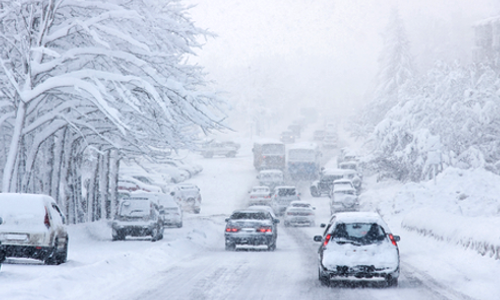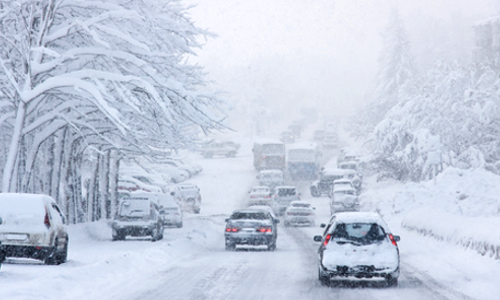

Coal ash—the residue from burning coal to generate electricity—is abundant and cheap. Often free for the taking, in fact. And it’s one way that at least some Midwestern communities provide traction on snowy and icy roads.
But what’s left behind in the nearby water and soil when this byproduct from coal-fired power plants is spread on roads?
Photo courtesy of Shutterstock
Tom Adams, executive director of the American Coal Ash Association, dismisses the bottom ash used on roadways as mere “coal dirt.” And although it harbors varying amounts of toxic heavy metals including arsenic, lead, chromium and cadmium, Adams says the amounts are no higher than in the rock and dirt native to many areas of the country.
“None of these things exist in concentrations anywhere near what the EPA is concerned about,” he said.
Barb Gottlieb, director of environment and health for Physicians for Social Responsibility, isn’t so sure.
“This should be recognized as a problem,” Gottlieb said.
The heavy metals present in coal ash are, at sufficient concentrations, “some of the most dangerous substances in the world.” Chromium, for example, is a “very dangerous carcinogen,” especially when wet, Gottlieb noted.
“This Isn’t Sand”
Lisa Evans, a lawyer who focuses on coal ash-related issues for Earthjustice, said it’s not clear just how the metals in coal ash might impact their surroundings.
The technology generally used to assess the toxicity of coal ash has been dismissed as largely uninformative, and a new process approved two years ago by the U.S. Environmental Protection Agency (EPA) is not yet in wide use.
“I don’t think it can be assumed to be safe,” Evans said. “This isn’t sand. It’s not benign.”
Adding to the uncertainty about the environmental and health effects of coal ash is a broader lack of government oversight. The EPA has made attempts to write regulations pertaining to the disposal and use of coal ash, but has been hampered repeatedly by Congress.
Regulations at the state level are spotty. In Missouri, for example, bottom ash used on roads is specifically exempted from the oversight provided by the solid-waste permit process, provided that “a health hazard is not created.”
“They Wouldn’t Give It to Us if It Wasn’t Safe”
The use of coal ash—also known as cinders—to create traction on snowy and icy roads goes way back.
Joe Feldman remembers the black grit underfoot when he was growing up decades ago in the country near St. Louis. Now, as the public works director for Franklin County, MO, he occasionally sends trucks to Ameren Missouri’s Labadie coal-fired plant, located outside of St. Louis, to fill up with bottom ash.
Nationwide, according to the Coal Ash Association, some 256,000 tons of waste from coal-burning plants—the bulk of it what’s known as bottom ash, leftover at the bottom of the combustion chamber after coal is burned—were distributed for use on roads in 2012.
Among utilities in the Midwest, American Electric Power, for example, distributes about 3.5 percent of the bottom ash from its 25 coal-fired plants for use on roads. A spokesman for Ameren Missouri said that “less than two percent of our total ash production” is distributed for use on roads. It goes to numerous nearby communities as well as the state’s transportation department.
And the city power utility in Muscatine, IA, provides ash both to Muscatine’s public works department and several communities in Illinois.
For public works departments, the deal provides an effective salt substitute for minimal or no cost.
“I’m a big supporter of cinders,” said Randy Hill, Muscatine’s director of public works. He doesn’t believe bottom ash poses any health or environmental threat.
“They wouldn’t give it to us if it wasn’t safe,” Hill said. “It seems to pass all its requirements.”
Questions About Testing
While test results for ash used in Muscatine don’t indicate a problem, Lisa Evans, of Earthjustice, is less confident about the assurances. The amount of heavy metals such as arsenic, mercury, lead, chromium and cadmium can vary significantly, depending on the source of the coal, and how it was burned.
An EPA test of many samples of bottom ash found that the concentration of arsenic, for example, ranged from 0.5 to 168 parts per million (ppm), with a median of 4.5. Typical levels of arsenic in soil range from 1 to 40 ppm, with an average of 3-4 ppm, according to the Centers for Disease Control.
However, although utilities and state environmental protection agencies do sometimes test samples of bottom coal ash in an attempt to assess the toxicity of liquid leaching from it, Evans said there are issues with the test.
One procedure that is frequently used—the Toxicity Characteristic Leaching Procedure (TCLP)—is not a reliable instrument, she said. It is designed to gauge leachate from a material stored in a sanitary landfill. That is a very different environment from a road, Evans said, where ash undoubtedly would get wet, and perhaps wash into a ditch or storm sewer where it would stay wet and possibly leach toxic compounds into water and soil.
David Kosson shares Evans’ concerns. He is the Cornelius Vanderbilt Professor of Engineering at Vanderbilt University, and was involved in developing what is thought to be a more accurate measurement of toxic leachate from a wide variety of potentially dangerous materials.
As far back as 1990, the EPA was questioning the best way to assess the true hazards posed by heavy metals and other potential toxic compounds. The EPA consulted its Science Advisory Board about the need for a suitable way to measure toxic leachate.
In a 1999 letter to then EPA Administrator Carol Browner, the committee wrote, that its “single most important recommendation is that EPA improve leach test procedures, validate them in the field and then implement them.”
Kosson was involved in developing a group of four tests, known as the leaching environmental assessment framework, or LEAF. The tests are capable of reflecting a range of different conditions, and so are more accurate than the tests that came before.
The EPA only formally approved widespread use of the LEAF tests in 2012, Kosson said. And he believes they are not widely used at this point. That means that assurances about the safety of bottom ash used on roads likely are based on bad information from an inappropriate test, or no information.
The widely-used TCLP, “has no relevance” to the question about the safety of bottom ash on roads, Kosson said.
Kosson said that the LEAF test would be “appropriate” for assessing toxicity of bottom ash, and that “There are not other tests that would provide the same information and be as useful.”
Given the persistent questions about how the toxins in coal ash behave in the environment, Evans contends that the ash needs to be tested using the LEAF analysis, the latest technology, before it’s handed out to be distributed far and wide.
And in the absence of that analysis, Gottlieb said, “Because we don’t know, we have to be careful, and not use toxic substances that can leak into the water or be inhaled.”
Visit EcoWatch’s COAL and WATER pages for more related news on this topic.

 233k
233k  41k
41k  Subscribe
Subscribe 

